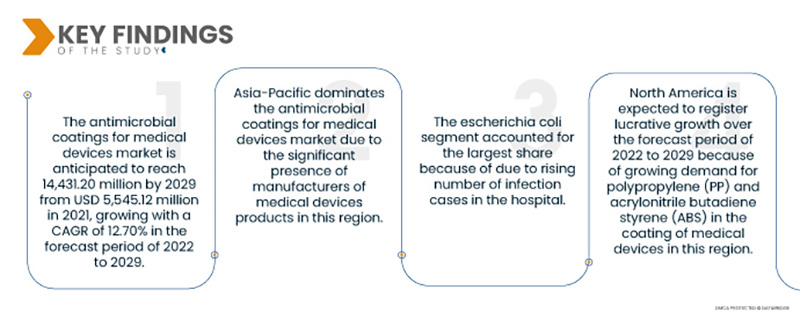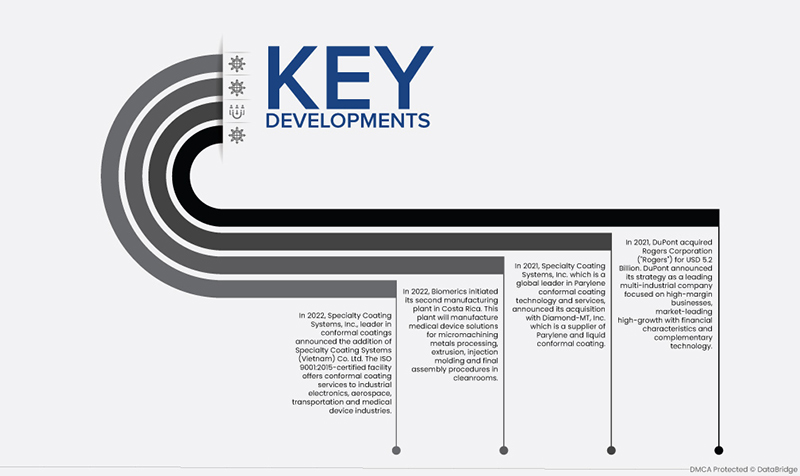의료 관련 감염(HCAI)은 공중 보건 문제이자 전 세계 사망률과 이환율의 주요 원인입니다. 유럽 질병예방통제센터(ECDC)는 유럽에서 매년 약 320만 명의 환자가 HCAI에 걸린다고 추산했습니다. 현대 의료는 환자를 치료하고 의료 관련 감염(HCAI)으로부터 회복하도록 돕기 위해 다양한 의료 기기를 사용합니다. 따라서 의료 관련 감염(HCAI) 환자를 치료하기 위한 의료 기기 수요 증가는 향후 몇 년간 시장 성장을 촉진할 것으로 예상됩니다.
데이터 브리지 마켓 리서치(Data Bridge Market Research)에 따르면, 의료기기용 항균 코팅 시장은 2021년 55억 4,512만 달러에서 2029년 144억 3,120만 달러로 성장할 것으로 예상되며, 2022년부터 2029년까지 연평균 성장률(CAGR) 12.70%로 성장할 것으로 전망됩니다. 주요 신규 응용 분야에서의 사용량 증가는 예측 기간 동안 시장 성장에 잠재적인 기회를 제공할 것입니다.

의료 분야 전반에 걸쳐 항균 코팅 채택이 증가함에 따라 시장 성장률이 증가할 것으로 예상 됩니다.
항균 코팅은 표면에 사용되는 화학 물질로, 질병을 유발하는 알레르겐과 미생물의 성장을 막거나 감소시킬 수 있습니다. 이러한 코팅과 표면은 표면의 내구성, 세척성, 외관 및 내식성을 향상시킬 뿐만 아니라, 질병을 유발하는 미생물로부터 인체를 보호합니다. 항균 코팅은 강력한 세척제 사용과 소독제 및 살균제의 과다 사용을 줄이는 데 도움이 됩니다. 따라서, 의료 분야를 중심으로 항균 코팅 도입이 증가함에 따라 의료기기용 항균 코팅 시장이 전 세계적으로 성장할 것으로 예상됩니다.
보고서 범위 및 시장 세분화
보고서 메트릭
|
세부
|
예측 기간
|
2022년부터 2029년까지
|
기준 연도
|
2021
|
역사적인 해
|
2020 (2015~2020년으로 맞춤 설정 가능)
|
양적 단위
|
매출(백만 달러), 볼륨(단위), 가격(달러)
|
다루는 세그먼트
|
제품 유형(은 항균 코팅, 구리 항균 코팅, 기타), 코팅(은, 키토산, 이산화티타늄, 알루미늄, 구리, 아연, 갈륨, 기타), 유형(대장균, 녹농균, 리스테리아균, 기타), 첨가제(은 이온 항균 첨가제, 유기 항균 첨가제, 구리 항균 첨가제, 아연 항균 첨가제), 소재(그래핀 소재, 은 나노입자, 폴리양이온 하이드로젤, 폴리머 브러시, 덴드리머, 기타), 수지 유형(에폭시, 아크릴, 폴리우레탄, 폴리에스테르, 기타), 형태(액체, 분말, 에어로졸), 적용 분야(수술 기구, 이식형 장치, 가이드와이어, 맨드렐 및 몰드, 카테터, 기타)
|
포함 국가
|
미국, 북미의 캐나다 및 멕시코, 독일, 프랑스, 영국, 네덜란드, 스위스, 벨기에, 러시아, 이탈리아, 스페인, 터키, 유럽의 기타 유럽 국가, 중국, 일본, 인도, 한국, 싱가포르, 말레이시아, 호주, 태국, 인도네시아, 필리핀, 아시아 태평양(APAC)의 기타 아시아 태평양(APAC), 사우디아라비아, UAE, 남아프리카 공화국, 이집트, 이스라엘, 중동 및 아프리카(MEA)의 일부인 기타 중동 및 아프리카(MEA), 남미의 일부인 기타 남미 국가.
|
시장 참여자 포함
|
Siemens(독일), Virtalis(영국), CAE Healthcare(미국), General Electric(미국), Virtual Realities LLC(영국), Qualcomm Technologies Inc.(미국), Samsung(한국), Vuzix(미국), Mimic Technologies Inc(미국), Brainlab AG(독일), SAMSUNG(한국), Brainlab AG, Firsthand(미국), ImmersiveTouch, Inc(미국), Koninklijke Philips NV(네덜란드), Medical Realities Ltd(영국), PSICO SMART APPS, SL(스페인), SimX(캐나다)
|
보고서에서 다루는 데이터 포인트
|
Data Bridge Market Research에서 큐레이팅한 시장 보고서에는 시장 가치, 성장률, 세분화, 지리적 범위, 주요 기업 등 시장 시나리오에 대한 통찰력 외에도 심층적인 전문가 분석, 지리적으로 대표되는 회사별 생산 및 용량, 유통업체 및 파트너의 네트워크 레이아웃, 자세하고 업데이트된 가격 추세 분석, 공급망 및 수요에 대한 부족 분석이 포함됩니다.
|
세그먼트 분석:
의료 기기용 항균 코팅 시장은 제품 유형, 코팅, 유형, 첨가제, 재료, 수지 유형, 형태 및 응용 분야를 기준으로 세분화됩니다.
- 제품 유형을 기준으로 글로벌 항균 코팅 시장은 은 항균 코팅, 구리 항균 코팅 및 기타로 구분됩니다.
제품 유형 세그먼트의 은 항균 코팅 세그먼트는 의료 기기 시장을 위한 항균 코팅을 지배할 것으로 예상됩니다.
은 항균 코팅 부문은 다양한 응용 분야에 유용한 은 항균 코팅의 높은 열 전도성, 높은 전기 전도성 및 우수한 내식성 특성으로 인해 49.75%의 시장 점유율로 글로벌 항균 코팅 시장을 지배할 것으로 예상됩니다.
- 코팅을 기준으로 세계 항균 코팅 시장은 은, 키토산, 구리, 아연, 갈륨, 알루미늄, 이산화티타늄 등으로 구분됩니다. 은 코팅의 다양한 특성이 의료 기기, 금속 및 기타 표면에 유리하기 때문에 은 부문이 31.95%의 시장 점유율을 기록하며 세계 항균 코팅 시장을 주도할 것으로 예상됩니다.
- 글로벌 항균 코팅 시장은 유형별로 대장균, 슈도모나스, 리스테리아 등으로 구분됩니다. 병원 내 감염 사례 증가로 인해 대장균이 35.21%의 시장 점유율을 기록하며 글로벌 항균 코팅 시장을 주도할 것으로 예상됩니다.
- 첨가제를 기준으로 볼 때, 세계 항균 코팅 시장은 은 이온 항균 첨가제, 아연 항균 첨가제, 구리 항균 첨가제, 그리고 유기 항균 첨가제로 구분됩니다. 은 이온 항균 첨가제 부문은 은이 박테리아의 생존, 군집 형성 및 번식을 억제하는 항균제로 사용되기 때문에 35.73%의 시장 점유율로 세계 항균 코팅 시장을 주도할 것으로 예상됩니다.
- 소재별로 보면, 세계 항균 코팅 시장은 그래핀 소재, 은 나노입자, 폴리양이온성 하이드로젤, 폴리머 브러시, 덴드리머 등으로 구분됩니다. 그래핀 소재 부문은 다양한 미생물 및 박테리아에 대한 보호 효과로 인해 29.47%의 시장 점유율을 기록하며 세계 항균 코팅 시장을 주도할 것으로 예상됩니다.
- 수지 유형을 기준으로 글로벌 항균 코팅 시장은 에폭시, 아크릴, 폴리우레탄, 폴리에스터 및 기타로 구분됩니다.
수지 유형 세그먼트의 에폭시 세그먼트는 의료 기기 시장을 위한 항균 코팅을 지배할 것으로 예상됩니다.
에폭시 수지는 다양한 분야에서 많은 용도로 활용되고 표면 개질 및 코팅 기술에 대한 화학적 개질 공정이 비교적 용이하기 때문에 에폭시가 40.02%의 시장 점유율로 글로벌 항균 코팅 시장을 지배할 것으로 예상됩니다.
- 전 세계 항균 코팅 시장은 형태에 따라 액상, 에어로졸, 분말 형태로 구분됩니다. 액상은 분말 형태보다 적은 양의 액상만으로도 충분하기 때문에 49.90%의 시장 점유율로 전 세계 항균 코팅 시장을 지배할 것으로 예상됩니다.
- 전 세계 항균 코팅 시장은 용도별로 병원, 실내 공기/HVAC, 제약 장비, 곰팡이 제거, 부식 방지, 건축 및 건설, 식품 포장 장비로 구분됩니다. 전 세계적으로 HCAI(염소산칼슘)가 증가하고 의료기기용 항균 코팅에 대한 수요가 증가함에 따라 병원 부문이 27.80%의 시장 점유율을 기록하며 전 세계 항균 코팅 시장을 주도할 것으로 예상됩니다.
- 최종 사용자 기준으로 세계 항균 코팅 시장은 제약 산업, 페인트 및 코팅 산업, 포장 산업, 섬유 산업, 전자 산업, 금속 산업, 수처리 산업 등으로 구분됩니다. 섬유 산업은 팬데믹으로 인해 보호복과 항균 코팅 마스크에 대한 수요가 증가함에 따라 31.85%의 시장 점유율로 세계 항균 코팅 시장을 주도할 것으로 예상됩니다.
주요 플레이어
Data Bridge Market Research는 의료기기용 항균 코팅 시장의 주요 기업으로 다음 회사를 인식합니다. 의료기기용 항균 코팅 시장 주요 기업으로는 Siemens(독일), Virtalis(영국), CAE Healthcare(미국), General Electric(미국), Virtual Realities LLC(영국), Qualcomm Technologies Inc.(미국), Samsung(한국), Vuzix(미국), Mimic Technologies Inc(미국), Brainlab AG(독일), SAMSUNG(한국)이 있습니다.
시장 개발

- 2022년, 컨포멀 코팅 분야의 선두주자인 스페셜티 코팅 시스템즈(Specialty Coating Systems, Inc.)는 스페셜티 코팅 시스템즈(베트남)(Specialty Coating Systems (Vietnam) Co. Ltd.)의 인수를 발표했습니다. ISO 9001:2015 인증을 받은 이 시설은 산업용 전자, 항공우주, 운송 및 의료기기 산업에 컨포멀 코팅 서비스를 제공합니다. 이번 확장을 통해 베트남 시장에서의 신뢰도를 더욱 높일 수 있을 것으로 기대됩니다.
- 2022년, 바이오메릭스는 코스타리카에 두 번째 생산 공장을 설립했습니다. 이 공장은 미세 가공 금속 가공, 압출, 사출 성형 및 클린룸에서 최종 조립 공정을 위한 의료기기 솔루션을 생산할 예정입니다. 이러한 변화는 시장에서 증가하는 의료기기 솔루션 수요를 충족하기 위한 것입니다.
- 2021년, 파릴렌 컨포멀 코팅 기술 및 서비스 분야의 글로벌 선두 기업인 스페셜티 코팅 시스템즈(Specialty Coating Systems, Inc.)는 파릴렌 및 액상 컨포멀 코팅 공급업체인 다이아몬드-MT(Diamond-MT, Inc.)와의 인수를 발표했습니다. 이번 인수는 회사 성장에 새로운 기회를 제공할 것입니다.
- 2021년 듀폰은 로저스 코퍼레이션(이하 "로저스")을 52억 달러에 인수했습니다. 듀폰은 고마진 사업, 시장 선도적인 고성장, 재무적 특성, 그리고 상호 보완적인 기술에 집중하는 선도적인 다산업 기업으로서의 전략을 발표했습니다. 이번 확장은 듀폰이 로저스 코퍼레이션의 지원을 받아 사업을 발전시키는 데 도움이 될 것입니다.
지역 분석
지리적으로 의료 기기용 항균 코팅 시장 보고서에 포함된 국가는 다음과 같습니다.
미국, 북미의 캐나다 및 멕시코, 독일, 프랑스, 영국, 네덜란드, 스위스, 벨기에, 러시아, 이탈리아, 스페인, 터키, 유럽의 기타 유럽 국가, 중국, 일본, 인도, 한국, 싱가포르, 말레이시아, 호주, 태국, 인도네시아, 필리핀, 아시아 태평양(APAC)의 기타 아시아 태평양(APAC), 사우디아라비아, UAE, 남아프리카 공화국, 이집트, 이스라엘, 중동 및 아프리카(MEA)의 일부인 기타 중동 및 아프리카(MEA), 남미의 일부인 기타 남미 국가.
Data Bridge Market Research 분석에 따르면:
아시아 태평양 지역은 2022년부터 2029년까지의 예측 기간 동안 의료 기기용 항균 코팅 시장 에서 주도적인 지역입니다.
아시아 태평양 지역은 의료기기 제조업체들의 활발한 진출로 의료기기용 항균 코팅 시장을 주도하고 있습니다. 더욱이, 의료기기용 항균 코팅 소비 증가는 의료기기용 항균 코팅 시장의 성장을 더욱 촉진할 것입니다.
북미는 2022년부터 2029년까지 의료 기기 시장을 위한 항균 코팅 분야에서 가장 빠르게 성장하는 지역으로 추정됩니다.
북미 지역은 개발도상국의 의료 시설 확장 및 빠른 성장으로 인해 2022년부터 2030년까지 예측 기간 동안 성장할 것으로 예상됩니다. 또한, 의료기기 코팅에 사용되는 폴리프로필렌(PP)과 아크릴로니트릴 부타디엔 스티렌(ABS) 수요 증가로 인해 이 지역 시장 성장이 더욱 가속화될 것으로 예상됩니다.
의료 기기용 항균 코팅 시장 보고서 에 대한 자세한 내용은 여기를 클릭하세요 - https://www.databridgemarketresearch.com/reports/global-antimicrobial-coatings-medical-devices-market










